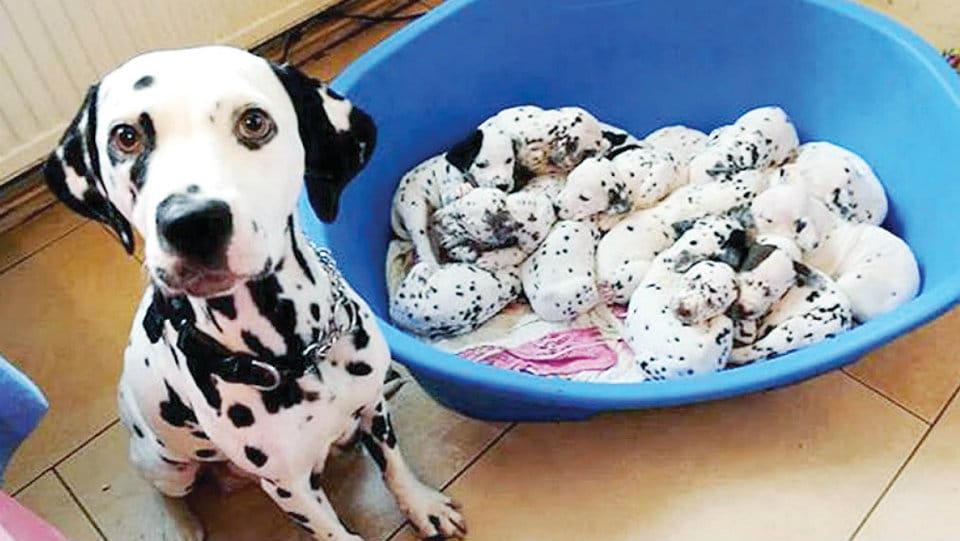In this week’s Pet Talk, Maneka explains about bathing rabbit, rehydrating a bird and what an unqualified person can do for a healthy delivery of puppies
By Maneka Gandhi
What is something people do with their cats that they should absolutely not be doing?
• Never declaw a cat. It is inhumane and torture for them for their whole lives.
• Never hit, strike, kick, or in any way attempt to hurt a cat. They are defenceless creatures that rely on their human caretakers. This behaviour, whatever your so called reason for it, is abuse.
• Not spaying/ neutering their cat. You are reducing the stray population by fixing them, and you are also helping to prevent them from getting certain cancers.
• Finding obesity cute. Your cat is suffering. He cannot bathe himself properly, he is likely to be headed very quickly for diabetes and other diseases.
• Never have a healthy animal put down. If you can no longer afford them you still have a duty of care to find them a new home, and ensure they continue to have a good life.
• Putting off veterinary treatment for a sick or injured cat. I don’t care how, but you get that cat treated. Borrow money or get help from animal welfare.
Is it true that bathing a rabbit in water can be harmful to the rabbit?
Rabbits have a fear of water (naturally). However, this is not the case with all the rabbits and, especially in summer days, some may actually like relaxing in water for some time.
Rabbits are a self cleaning breed with dense coats which, once wet, cannot be easily dried.
Making them bathe would not only lead to fur-fall, but can also cause a heart-attack (during extreme cases).
Their digestive system can also get troubled and it can lead to loose motions which prove fatal.
Apart from all these reasons, water entering their ears and causing infection is also one of the reasons rabbit owners are asked to keep them away from water.
In case of non-availability of a veterinary doctor, what can an unqualified person do for a healthy delivery of puppies?
The signs of dog labour:
• She becomes restless.
• She stops eating up to 24 hours before labour.
• She may paw at her bedding, as if preparing a nest.
• She starts licking her vulva.
• She may vomit or discharge mucus.
Supplies to have on hand:
• Whelping box.
• A laundry basket lined with a heating pad and a blanket.
• A stack of clean towels.
• Emergency supplies.
When you see a greyish sac drop from the vulva, this means that there’s a puppy on the way! The mother should pass the first puppy within an hour of the sac appearing. If she doesn’t, it’s time to call the vet to discuss whether to bring her in. Here are a few things that you might have to do following each puppy’s birth, if the mother doesn’t do them herself.
Remove the membrane: Puppies are born in a thin membrane that looks like plastic wrap, which needs to be removed within six minutes so the pup doesn’t suffocate. Normally, the mother will do this immediately. If she doesn’t, then you’ll have to break the membrane yourself.
Rub the puppy with a towel: Right after the membrane comes off, the mother dog will normally lick the puppy, which will stimulate it to breathe and cry. If she doesn’t do this, rub the puppy vigorously with a towel until it starts breathing on its own.
Discard the afterbirth: Within five to fifteen minutes after each birth, a mass of blackish-green tissue, called the placenta, or afterbirth, should follow. Once the puppy is born, the placenta is entirely useless. You can discard it.
Cut the umbilical cord: If the momma pup doesn’t chew through each umbilical cord on her own, you will have to cut the cord. If you do, be sure to use sterilised scissors. Cut about an inch from the pup’s belly.
How to tell when the dog’s eyesight becomes weak?
Regardless of your pet’s age, vision issues can come into play. Here are some ways to tell if the dog is having a difficult time with his/ her vision.
Toy test: Take their favourite toy, or treat, and see how far you can get before they no longer know it’s there (Don’t use a bright or distinctive colour, or shape, because they might recognise even when they can’t really see it). Another method involves simply paying attention to when they can recognise a friend walking towards them from a distance. Remember dogs have a good sense of smell and can recognise the smell even when they can’t see the person.
Contact the vet: In any case of suspected vision problem, visit the vet. You may need to see a specialist. Your Veterinarian will usually refer you to one right away for a full evaluation. New strides in treating vision loss can mean diet changes, medications, cataract surgery .
What’s that on the eyes?: Notice a fuzziness in, or on, her eyes? Sometimes pets can see perfectly through, or around, these opacities, but not usually. Typically, it’s evidence of vision loss.
Night vision test: Night vision is often the first to go. But that’s hard to know because you’re not exactly watching your pet when it’s dark in the room. And pets don’t tend to bump into furniture — they know where it all is.
Can stray dogs which have been sterilised, be relocated to any other place?
The only humane, legal and scientific way of dealing with street dogs is to get them vaccinated and sterilised under the Animal Birth Control (ABC) programme. Under this programme, stray dogs are picked up, neutered, vaccinated against rabies, and released in the respective areas from where they had been captured, which is in accordance with the Animal Birth Control Rules, 2001, framed under section 38 of the Prevention of Cruelty to Animals Act, 1960, and as per the orders of Supreme Court of India. There is scientific thought behind restoring a sterilised dog to his original habitat. Dogs are territorial animals. They mark out their territories based on the food available, and they do not let outsiders come in. When these local dogs are removed from their territory, other dogs move in to occupy them. These may not be sterilised, so the problem continues for that locality. Dog fights increase, as any new dog entering a territory is attacked by the dogs already in that area, and non-sterilised dogs continue to mate and produce litters.
How to rehydrate a dehydrated bird? Should plain water be avoided?
Dehydration is very important to recognise and understand. Most of the sick birds die of dehydration first, before the illness that caused their problem. To dehydrate something is to remove the moisture.
To remedy dehydration, use: Commercial electrolyte fluids, such as Pedialyte; or, mix one pint of water, one pint of Gatorade, 1 teaspoon of honey or Karo syrup, 1 level teaspoon of aluminum-free baking soda (such as “Bob’s Red Mill Baking Soda”),
1 level teaspoon table salt.
Caution: Measure with care; inaccurate measurements can cause severe diarrhoea. Orange or cherry juice helps in hydrating your bird. Force-feeding is necessary when the energy levels drop so low that the bird does not eat or drink and is in danger of dying. You may try getting fluids into the sick birds using a dropper.
Crop needling is recommended for those who are confident with the crop needle technique (The crop needle is a blunt needle, or crop tube, passed gently and directly into the crop of the bird). This procedure is technically difficult and should not be undertaken by those who are inexperienced, as it is potentially fatal if done incorrectly.
If the bird is alert then the bird can be given a solution of water, salt and sugar, through an eye dropper, strictly avoiding the nostrils. The fluid should be at room temperature or lukewarm. A cold bird should never be given any fluids. Unflavoured Pedialyte can also be used as an emergency rehydrating substitute. Plain water shouldn’t be given unless nothing is available.








Recent Comments